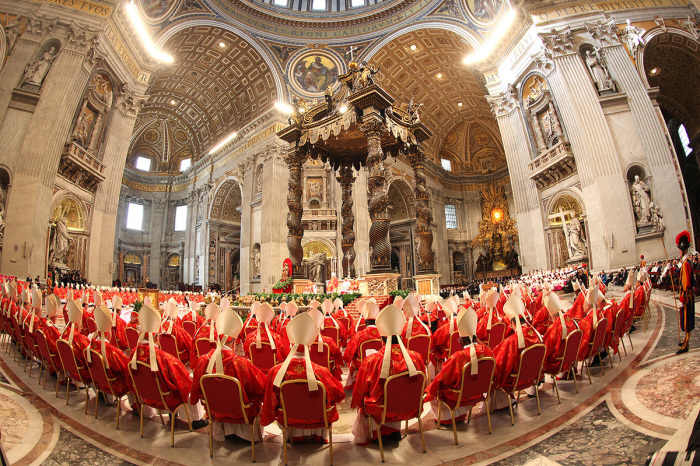
Following the death of Pope Francis at age 88 on Monday, the office of the pontiff will remain vacant until a successor is chosen and elected. Francis served for 12 years, longer than his immediate predecessor, Pope Benedict XVI, but less than half of the 26 years the late Pope St. John Paul II served as the successor to St. Peter.
Matthew Schmalz, a professor of religious studies at the Roman Catholic Church-affiliated Holy Cross College in Worcester, Massachusetts, is a noted expert on Catholicism and the papacy.
In an interview with The Christian Post, Schmalz explained the process for electing a new pope and shared his thoughts about potential successors to Francis and the future of the Catholic Church.
How the pope is selected
“A pope is elected in a conclave, which literally means, in Latin, a room that can be locked,” Schmalz explained. “And so, they’re locked away in the Sistine Chapel, and a pope, in order to be elected, needs a two-thirds majority of the eligible voting members of the College of Cardinals.”
After noting that many of the Cardinals appointed by Pope Francis “come from the margins of the Catholic world,” he stressed how this means “many of the cardinals don’t actually know each other that well before the conclave begins.” While Schmalz believes there won’t be “a deadlocked conclave that would last for days and days,” he anticipates that “it will be longer than most recent conclaves because many of the cardinals don’t know each other that well.”
“Before the conclave itself, there’ll be two meetings, there’ll be meetings called general consistories where members of the College of Cardinals will talk about issues facing the church and that will be really crucial in this case because there are so many cardinals from the margins of the Catholic world,” he said.
“I think, in this case, what’s going to happen, because many of the cardinals aren’t from Western Europe or they don’t go to Rome very often, they might turn to people who are already known.”
The College of Cardinals has 252 members. However, only 135 of them are eligible to participate in the election of a new pope. The remaining 117 are 80 years old or older, and due to the declaration of Pope St. John Paul II in the 1996 apostolic constitutionUniversi dominici gregis, are ineligible to vote in a papal conclave.
A pope must secure the support of a two-thirds majority of the cardinals present for the conclave. It often takes several ballots to reach this threshold. The 2013 election of Francis went to five ballots, while it took four ballots before Benedict XVI became pope. Candidates receiving the least number of votes are eliminated in each round of voting until one candidate reaches the threshold.
The overwhelming majority of eligible cardinal electors (108) were appointed by Pope Francis. Twenty-two were appointed by Pope Benedict XVI, and the remaining five were installed by Pope St. John Paul II.
At 17, Italy has the highest number of cardinal electors. The United States has 10, while Brazil has seven. Spain and France have five cardinal electors each, while Argentina, Canada, India, Poland and Portugal each have four. Germany, the Philippines and the United Kingdom all have three cardinal electors. The countries with two cardinal electors are the Ivory Coast, Japan, Mexico and Switzerland.
Countries with only one cardinal elector apiece are: Algeria, Australia, Belgium, Bosnia and Herzegovina, Burkina Faso, Cape Verde, the Central African Republic, Chile, Colombia, Cuba, the Democratic Republic of the Congo, Croatia, East Timor, Ecuador, Ethiopia, Ghana, Guatemala, Guinea, Haiti, Hong Kong, Hungary, Indonesia, Iran, Iraq, Jerusalem, Kenya, South Korea, Lithuania, Luxembourg, Madagascar, Malaysia, Malta, Mongolia, Morocco, Myanmar, the Netherlands, New Zealand, Nicaragua, Nigeria, Pakistan, Paraguay, Papua New Guinea, Peru, Rwanda, Serbia, Singapore, South Africa, South Sudan, Sri Lanka, Sweden, Tanzania, Thailand, Tonga and Uruguay.
In the most recent papal vacancies, the office of Bishop of Rome remained vacant for around two weeks. In 2005, following the death of John Paul II on April 2, 2005, Benedict XVI was chosen as his successor on April 19, 2005. After the resignation of Benedict on Feb. 25, 2013, Francis was elected two weeks later on March 13, 2013.
The most likely replacements for Pope Francis
Schmalz told CP about the pattern that has emerged at previous conclaves, where “there are usually factions who will subtly and sometimes not so subtly politick before the conclave in these general consistories.”
“There are standard bearers for each faction depending on what is seen as being necessary for the church, either a younger pope or an older one, a more conservative or more liberal,” he added.
When asked by CP for his thoughts on which factions and candidates would emerge victorious in the forthcoming conclave, Schmalz said, “There are three basic directions that the cardinals can go in the next conclave: One is to continue the reforms of Pope Francis, two is to roll them back, or number three is simply take a breather and … have someone who is … sensitive to pastoral concerns and so forth, but is not going to make great changes.”
Schmalz identified Luis Cardinal Tagle, former Archbishop of Manila in the Philippines who now serves as Pro-Prefect of the Section of the First Evangelization and New Particular Churches of the Vatican’s Dicastery for Evangelization, and Cardinal Matteo Zuppi of the Archdiocese of Bologna in Italy as possible preferred candidates among those who “would like to see the reforms of Pope Francis continue.”
“They’re both friends of Pope Francis and are known for being, relatively, speaking progressive,” he added.
Conversely, Schmalz singled out Cardinal Robert Sarah of Guinea as a possible pick among those seeking to “roll back the reforms of Pope Francis.” Schmalz contends that Sarah would be a “Trump-like pope,” highlighting the cardinal’s “following among conservative Catholics, interestingly enough in the Western world, particularly in the United States and also Western Europe.”
“The cardinal that I think is most interesting to look at, and he hasn’t been mentioned as much this time as other times, is a guy named Malcolm Cardinal Ranjith, who is now the archbishop of Colombo in Sri Lanka. He was friends with Pope Benedict, but after the bombings in Sri Lanka, he seemed to assume a role that was much more in support of Pope Francis. So he could be sort of a bridge-builder between conservatives and liberals and people who would like a pope from the global south.”
Looking back on Francis’ 12-year-papacy, Schmalz contends that “it’s going to be difficult, at least in the next pontificate that follows him, to choose someone who has a really different style.”
Characterizing Francis’ style as “interactive and people-friendly,” Schmalz projected that “at the very least, whether the next pope is traditionalist or progressive, you’ll probably see someone who has a sensitivity for people in getting out to meet them and so forth … is much more of a pastor than say a theologian or a philosopher.”
What’s next for the Catholic Church?
Schmalz also elaborated on the implications of a new pope on several of the hot-button issues and debates facing the Church today, including the Traditional Latin mass and the clergy sex abuse scandal. “If they elect a more traditionalist Cardinal as pope, I could see Pope Francis’ restrictions on the Latin mass being very easily moved back … because … there is a very vocal constituency that is quite upset that Pope Francis put in restrictions on the celebration of the Latin mass.”
Schmalz also discussed how a new pope might affect the church’s response to the “ongoing” sexual abuse scandal, predicting that the new pontiff would be “someone who […] at least gives the impression that there is transparency in church governance because […] one of the claims, which is certainly true about the sexual abuse scandal, is that it was aided and abetted by a very kind of inward-looking secretive church that wasn’t open to outside supervision or examination.”
Ryan Foley is a reporter for The Christian Post. He can be reached at: ryan.foley@christianpost.com

















